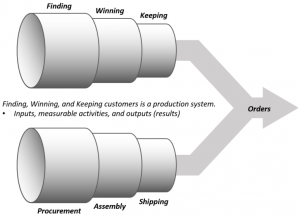SPIF Tip #17: Marketing and Sales is a Production Process
 Quality and
Quality and
- Sales opportunities are analogous to work-in-process in manufacturing. Salespeople qualify sales opportunities, people who are considering a purchase and who fit the company’s qualification criteria.
- Customers are analogous to finished goods. Salespeople close deals with people who buy their products and services and thus become customers.
Other parallels exist between sales and manufacturing, which we will explore as they arise. For now, the main point is that sales is indeed a process that produces customers, which every company needs to survive. It produces customers by adding value for people in the marketplace who have the kinds of problems that the company solves. The value that the sales process adds is not tangible as it is in manufacturing, but it is no less real.
If it’s not tangible, how do we know when the sales process is creating value? How do we know whether the process or any of its parts, such as an advertisement, a mailing, a Web page, or a sales call, are producing the intended result?
We know whether value has been added by the actions taken or not taken by the customer. In the sales process, value is most clearly and measurably defined as that which the customer will take action to obtain or keep. We know that the process has created value when the prospect reads and responds to the advertising copy, requests the offer presented by the mailing, opts in to the electronic newsletter, accepts our phone calls, or openly shares vital information with the salesperson. Prospects and customers take these actions to obtain value, and these actions can be measured. The most obvious measures are sales figures, which every company, manager, and salesperson already tracks. However, to truly improve a sales process, we need to go beyond sales figures and measure activities and results at various stages of the process.
Far from “dehumanizing” things, this perspective ensures companies can continuously improving their ability to do the right work for the right people at the right time.
Action Item:
A production perspective simplifies complex tasks by breaking them down in to manageable parts. Just as Rome, Paris, or New York were not built in a day, nor can your sales process be built in a day. Fortunately, however, working toward a production perspective of sales and marketing is the kind of work where little changes can create big improvements. Bring your team together and ask them to list what happens in the finding, winning, and keeping stages (sometimes called before, during, and after the sale).
Chances are they won’t immediately agree on what each stage is trying to accomplish, how they know if the work succeeded, and so forth.
Voila, you’ve gotten your team to start identifying where and how to begin improving.
From “Sales and Marketing the Six Sigma Way,” Page 16.

